|
What Greek island is the most often mentioned
yet one of the least visited by travelers?
The answer is Milos....
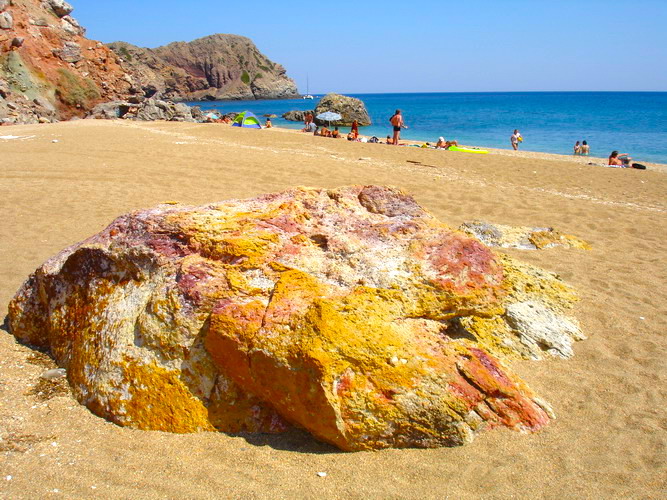 The reason it is mentioned so often is because of its rich history
and of course because this is where the famous Venus de Milo was
found that is now a centerpiece at the Louvre in Paris. The reason
it is not visited more is because tourists don't realize that besides
Santorini, Milos has the most extraordinary terrain of any of the
Cyclades due to its volcanic past. There are amazing rock formations,
hot springs and as many as seventy-five beaches, some of which rival
the best in all of Greece. Rich
in minerals even today, the island was inhabited during the Myceneaen
and Minoan periods and was one of the earliest civilizations of
the Cyclades islands. Formerly a Spartan colony, though remaining
neutral during the Peloponnesian war, Milos did not join the
Athenian league and was give the choice of paying tribute or being
destroyed. These negotiations were written about by Thucydides with
the people of Milos taking the point of view that by trusting
in God and having faith in human decency they would be spared. The
Athenian's point of view was that 'might makes right' and because
they were powerful they could do whatever they wanted including
wipe out the people of Milos, which they did in 416 BC,
the men massacred and the women and children turned into slaves.
Five hundred Athenians were sent to the island to re-colonize
it. It was the beginning of the end for the Athenians as well. The
massacre of the Melians exposed the Athenians as ruthless imperialists
and turned the ancient world against her in a way that mirrors events
of our own lives. The reason it is mentioned so often is because of its rich history
and of course because this is where the famous Venus de Milo was
found that is now a centerpiece at the Louvre in Paris. The reason
it is not visited more is because tourists don't realize that besides
Santorini, Milos has the most extraordinary terrain of any of the
Cyclades due to its volcanic past. There are amazing rock formations,
hot springs and as many as seventy-five beaches, some of which rival
the best in all of Greece. Rich
in minerals even today, the island was inhabited during the Myceneaen
and Minoan periods and was one of the earliest civilizations of
the Cyclades islands. Formerly a Spartan colony, though remaining
neutral during the Peloponnesian war, Milos did not join the
Athenian league and was give the choice of paying tribute or being
destroyed. These negotiations were written about by Thucydides with
the people of Milos taking the point of view that by trusting
in God and having faith in human decency they would be spared. The
Athenian's point of view was that 'might makes right' and because
they were powerful they could do whatever they wanted including
wipe out the people of Milos, which they did in 416 BC,
the men massacred and the women and children turned into slaves.
Five hundred Athenians were sent to the island to re-colonize
it. It was the beginning of the end for the Athenians as well. The
massacre of the Melians exposed the Athenians as ruthless imperialists
and turned the ancient world against her in a way that mirrors events
of our own lives.
|
|
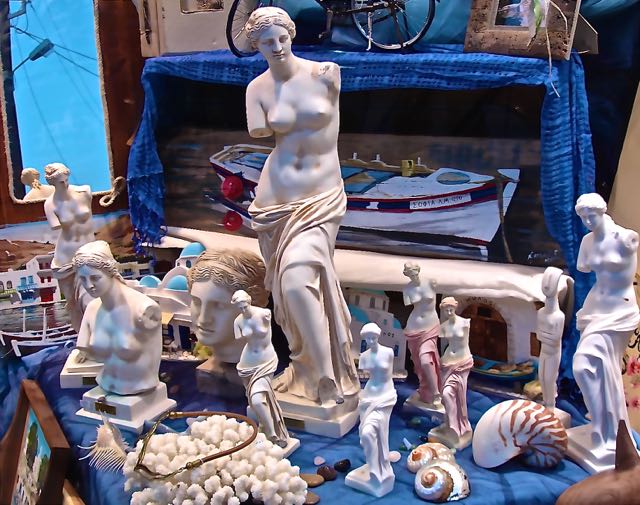 Eventually repopulated the island was home to
a Christian population that buried their dead in the famous catacombs,
the largest and most impressive in Greece. In 1820 the famous statue of Aphrodite, known as the Venus de Milo (The Venus of Milos)
was found by George Kentrotas and sold to the French Consul who
made a gift of it to Louis XVIII of France who put it in the Louvre Museum in Paris. It is one of the most recognizable pieces of art in the world. Eventually repopulated the island was home to
a Christian population that buried their dead in the famous catacombs,
the largest and most impressive in Greece. In 1820 the famous statue of Aphrodite, known as the Venus de Milo (The Venus of Milos)
was found by George Kentrotas and sold to the French Consul who
made a gift of it to Louis XVIII of France who put it in the Louvre Museum in Paris. It is one of the most recognizable pieces of art in the world.
Nowadays Milos is a combination industrial and
tourist island. The vast mineral deposits continue to be the wealth
of Milos and it has been said that the reason tourism has been
slow to take hold is because the people who own the mines don't
want the Melians to get used to the 'easy life' of running hotels
and restaurants because then they will never want to work in the
mines. However with the popularity of the island with vacationing
Greeks and the fact that you can't hide something as large and as
beautiful as a Greek island forever you have to accept that sooner
or later the mines will be worked by Albanians and other immigrants
while the islanders discover that the business of tourism is
also hard work. (Be sure to visit the Mineral and Mining Museum
in Adamas)
|
|
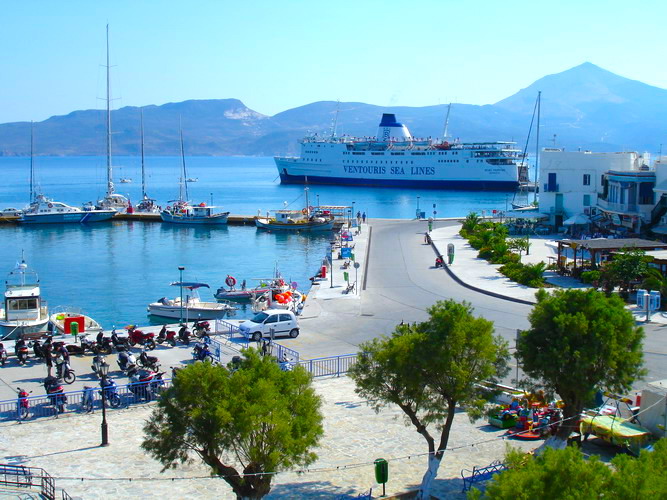 Sailing into Milos is almost as dramatic as
sailing into the caldera of Santorini. The port of Adamas is inside
a large bay and is considered the safest natural port in the Aegean.
The Germans used it during the Second World War. It was so important
to them that it was not liberated until the very end of the
war, the same day as Berlin! As you enter the bay you pass on your left the village of Klima,
famous for the boat houses right on the sea with their brightly
painted doors and the living quarters on the upper floors. Adamas
won't impress you with its beauty though parts of it are picturesque
and in many ways is a true picture of Greek island life, similar
to Ermouplis in Syros or Naxos town, only smaller. In the summer
it has a busy waterfront lined with cafes, restaurants, ATM's and
shops and features a mining museum as well as boat tours around
the island that visit some of the most spectacular beaches in Greece.
Because of the island's popularity with Greeks finding accommodation
by just showing up is not a sure thing in the summer and booking
in advance is not a bad idea. There are a number of good restaurants,
as there are on most islands that cater to Greek clientele instead
of just tourists. Sailing into Milos is almost as dramatic as
sailing into the caldera of Santorini. The port of Adamas is inside
a large bay and is considered the safest natural port in the Aegean.
The Germans used it during the Second World War. It was so important
to them that it was not liberated until the very end of the
war, the same day as Berlin! As you enter the bay you pass on your left the village of Klima,
famous for the boat houses right on the sea with their brightly
painted doors and the living quarters on the upper floors. Adamas
won't impress you with its beauty though parts of it are picturesque
and in many ways is a true picture of Greek island life, similar
to Ermouplis in Syros or Naxos town, only smaller. In the summer
it has a busy waterfront lined with cafes, restaurants, ATM's and
shops and features a mining museum as well as boat tours around
the island that visit some of the most spectacular beaches in Greece.
Because of the island's popularity with Greeks finding accommodation
by just showing up is not a sure thing in the summer and booking
in advance is not a bad idea. There are a number of good restaurants,
as there are on most islands that cater to Greek clientele instead
of just tourists.
Since the volcanic nature of Milos goes hand in hand with hot springs, there are several places around the island where there are hot springs. The most well known are the mineral baths in Adamas called Ta Loutra tou Lakkou, (Baths of the Pit) which was mentioned by Herodotus as a cure for skin diseases. It is currently recommended for neuro-arthritis and osteoarthritis, osteoporosis, muscle
pain and neuralgia, and rheumatism. Officially these are the only hot baths though there are many places around the island where hot water finds its way to the surface of the sea, for example at Provata, Canava, Paliohori and Skinopi.
|
|
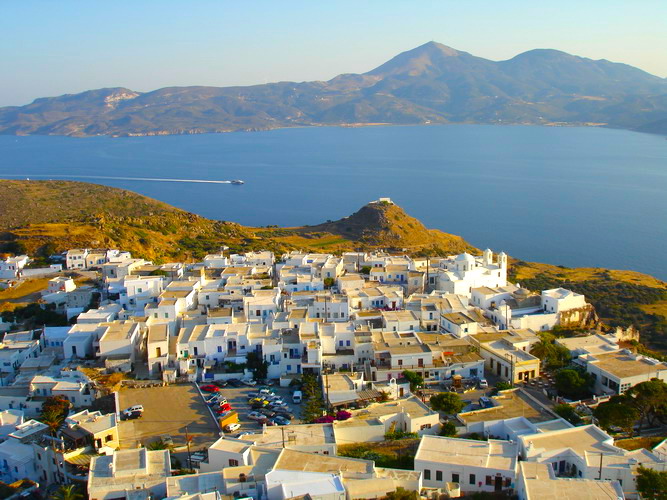 The
town of Plaka which is the true capital of the island is built on
a hill overlooking the sea just 5 kilometers from Adamas. Plaka
has the white-washed houses that people come to Greece to see, as
well as a Frankish castle on the ancient acropolis, a folk art museum,
an archaeology museum and a well preserved ancient theater which
hosts the Milos Festival every July when the island is visited by
Greek and International artists whose performances in such a
spectacular setting are not easy to forget. In the nearby village
of Tripiti are the Christian Catacombs, open from Tu-Sat 8:30 to 6:30 and Sunday 8:30 to 3:00 and regarded as one of the most important findings
from the first years of Christianity. Nearby is the field where
the famous 4th century statue of Aphrodite, otherwise known as the
Venus de Milo was found by farmer George Kontrotas in 1820. There
is a copy in the Archaeology Museum along with Neolithic, Mycenaean,
Minoan and Hellenistic artifacts from the island. At the Plakiaki
Gonia you can enjoy traditional Milos cooking and sign the petition
to have the Venus de Milo returned to the island. And don't leave Plaka without visiting the Milos Sand Museum where you can see sand from all over the world! The
town of Plaka which is the true capital of the island is built on
a hill overlooking the sea just 5 kilometers from Adamas. Plaka
has the white-washed houses that people come to Greece to see, as
well as a Frankish castle on the ancient acropolis, a folk art museum,
an archaeology museum and a well preserved ancient theater which
hosts the Milos Festival every July when the island is visited by
Greek and International artists whose performances in such a
spectacular setting are not easy to forget. In the nearby village
of Tripiti are the Christian Catacombs, open from Tu-Sat 8:30 to 6:30 and Sunday 8:30 to 3:00 and regarded as one of the most important findings
from the first years of Christianity. Nearby is the field where
the famous 4th century statue of Aphrodite, otherwise known as the
Venus de Milo was found by farmer George Kontrotas in 1820. There
is a copy in the Archaeology Museum along with Neolithic, Mycenaean,
Minoan and Hellenistic artifacts from the island. At the Plakiaki
Gonia you can enjoy traditional Milos cooking and sign the petition
to have the Venus de Milo returned to the island. And don't leave Plaka without visiting the Milos Sand Museum where you can see sand from all over the world!
|
|
 The
best way to see the beaches and dramatic coast of Milos with its
spectacular volcanic rock formations is by excursion boat, which
you can find in the port of Adamas. They leave at 9am and circle
the island. Some of them stop on the nearby island of Kimilos for lunch and they all
stop for swims along the way, returning at 8pm. If an 11 hour day
seems like too much for you the Delfini leaves from the port below
the Kypo Taverna on the south side of Milos at 11am and goes to
Kleftiko, the most impressive of the rock formations, stopping on
the way for a swim and returning at 2:30. If you wander around the harbor in the port of Adamas you will find several excursion boats and even some sailboats advertising their trips around the island with photos of where they go. If you don't have a mask and snorkel and flippers use whichever boat provides them. There is also a dive center in Pollonia for those who want to go scuba diving. A
car or motor-cycle can get you pretty much all over the island which
has an extensive road system if you are more of a land person. The
best way to see the beaches and dramatic coast of Milos with its
spectacular volcanic rock formations is by excursion boat, which
you can find in the port of Adamas. They leave at 9am and circle
the island. Some of them stop on the nearby island of Kimilos for lunch and they all
stop for swims along the way, returning at 8pm. If an 11 hour day
seems like too much for you the Delfini leaves from the port below
the Kypo Taverna on the south side of Milos at 11am and goes to
Kleftiko, the most impressive of the rock formations, stopping on
the way for a swim and returning at 2:30. If you wander around the harbor in the port of Adamas you will find several excursion boats and even some sailboats advertising their trips around the island with photos of where they go. If you don't have a mask and snorkel and flippers use whichever boat provides them. There is also a dive center in Pollonia for those who want to go scuba diving. A
car or motor-cycle can get you pretty much all over the island which
has an extensive road system if you are more of a land person.
|
|
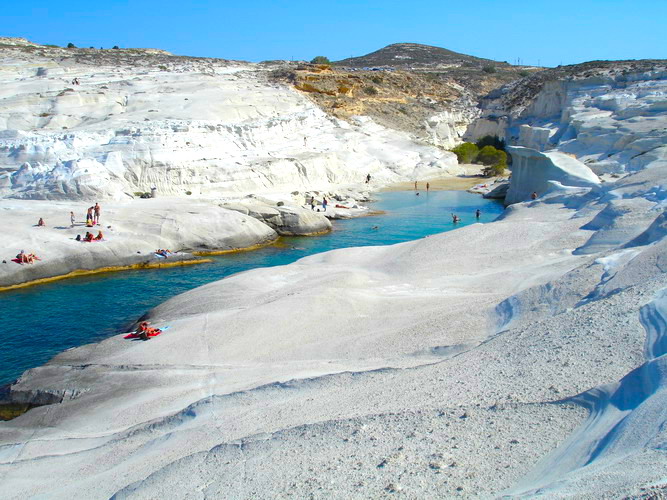 Some of the many beaches worth visiting are Lagkada, with its mineral
baths, Pollonia, a small fishing village where many people have their summer houses, Plathiena, a sandy beach
near Plaka, and the long sandy beaches of Paleohori and Provotas.
There are also hot springs at Paleohori. There are several sandy
beaches in the bay of Adamas as well as a salt water lake. Be sure
not to miss the white pumice rock formations at Sarakiniko with
the shipwreck on the rocks just around the bend, or the
incredible blue sulfuric water at Papafragas. The Island of Kimilos
which is reached by a small ferry from Pollonia as well as by the ferry to and from Pireaus on certain days, is certainly worth
at least a day trip. There are hotels, restaurants, and excursions
around that island to beaches and thermal springs, and staying
overnight or even several days would be an experience few tourists
have. You can find hotels, apartments and rooms on Kimilos through Booking.com's Kimolos Hotel Search or by contacting Aegean Thesaurus Travel. Some of the many beaches worth visiting are Lagkada, with its mineral
baths, Pollonia, a small fishing village where many people have their summer houses, Plathiena, a sandy beach
near Plaka, and the long sandy beaches of Paleohori and Provotas.
There are also hot springs at Paleohori. There are several sandy
beaches in the bay of Adamas as well as a salt water lake. Be sure
not to miss the white pumice rock formations at Sarakiniko with
the shipwreck on the rocks just around the bend, or the
incredible blue sulfuric water at Papafragas. The Island of Kimilos
which is reached by a small ferry from Pollonia as well as by the ferry to and from Pireaus on certain days, is certainly worth
at least a day trip. There are hotels, restaurants, and excursions
around that island to beaches and thermal springs, and staying
overnight or even several days would be an experience few tourists
have. You can find hotels, apartments and rooms on Kimilos through Booking.com's Kimolos Hotel Search or by contacting Aegean Thesaurus Travel.
|
|

 The reason it is mentioned so often is because of its rich history
and of course because this is where the famous Venus de Milo was
found that is now a centerpiece at the Louvre in Paris. The reason
it is not visited more is because tourists don't realize that besides
Santorini, Milos has the most extraordinary terrain of any of the
Cyclades due to its volcanic past. There are amazing rock formations,
hot springs and as many as seventy-five beaches, some of which rival
the best in all of Greece. Rich
in minerals even today, the island was inhabited during the Myceneaen
and Minoan periods and was one of the earliest civilizations of
the Cyclades islands. Formerly a Spartan colony, though remaining
neutral during the Peloponnesian war, Milos did not join the
Athenian league and was give the choice of paying tribute or being
destroyed. These negotiations were written about by Thucydides with
the people of Milos taking the point of view that by trusting
in God and having faith in human decency they would be spared. The
Athenian's point of view was that 'might makes right' and because
they were powerful they could do whatever they wanted including
wipe out the people of Milos, which they did in 416 BC,
the men massacred and the women and children turned into slaves.
Five hundred Athenians were sent to the island to re-colonize
it. It was the beginning of the end for the Athenians as well. The
massacre of the Melians exposed the Athenians as ruthless imperialists
and turned the ancient world against her in a way that mirrors events
of our own lives.
The reason it is mentioned so often is because of its rich history
and of course because this is where the famous Venus de Milo was
found that is now a centerpiece at the Louvre in Paris. The reason
it is not visited more is because tourists don't realize that besides
Santorini, Milos has the most extraordinary terrain of any of the
Cyclades due to its volcanic past. There are amazing rock formations,
hot springs and as many as seventy-five beaches, some of which rival
the best in all of Greece. Rich
in minerals even today, the island was inhabited during the Myceneaen
and Minoan periods and was one of the earliest civilizations of
the Cyclades islands. Formerly a Spartan colony, though remaining
neutral during the Peloponnesian war, Milos did not join the
Athenian league and was give the choice of paying tribute or being
destroyed. These negotiations were written about by Thucydides with
the people of Milos taking the point of view that by trusting
in God and having faith in human decency they would be spared. The
Athenian's point of view was that 'might makes right' and because
they were powerful they could do whatever they wanted including
wipe out the people of Milos, which they did in 416 BC,
the men massacred and the women and children turned into slaves.
Five hundred Athenians were sent to the island to re-colonize
it. It was the beginning of the end for the Athenians as well. The
massacre of the Melians exposed the Athenians as ruthless imperialists
and turned the ancient world against her in a way that mirrors events
of our own lives.  Eventually repopulated the island was home to
a Christian population that buried their dead in the famous catacombs,
the largest and most impressive in Greece. In 1820 the famous statue of Aphrodite, known as the Venus de Milo (The Venus of Milos)
was found by George Kentrotas and sold to the French Consul who
made a gift of it to Louis XVIII of France who put it in the Louvre Museum in Paris. It is one of the most recognizable pieces of art in the world.
Eventually repopulated the island was home to
a Christian population that buried their dead in the famous catacombs,
the largest and most impressive in Greece. In 1820 the famous statue of Aphrodite, known as the Venus de Milo (The Venus of Milos)
was found by George Kentrotas and sold to the French Consul who
made a gift of it to Louis XVIII of France who put it in the Louvre Museum in Paris. It is one of the most recognizable pieces of art in the world.  Sailing into Milos is almost as dramatic as
sailing into the caldera of Santorini. The port of Adamas is inside
a large bay and is considered the safest natural port in the Aegean.
The Germans used it during the Second World War. It was so important
to them that it was not liberated until the very end of the
war, the same day as Berlin! As you enter the bay you pass on your left the village of Klima,
famous for the boat houses right on the sea with their brightly
painted doors and the living quarters on the upper floors. Adamas
won't impress you with its beauty though parts of it are picturesque
and in many ways is a true picture of Greek island life, similar
to Ermouplis in Syros or Naxos town, only smaller. In the summer
it has a busy waterfront lined with cafes, restaurants, ATM's and
shops and features a mining museum as well as boat tours around
the island that visit some of the most spectacular beaches in Greece.
Because of the island's popularity with Greeks finding accommodation
by just showing up is not a sure thing in the summer and booking
in advance is not a bad idea. There are a number of good
Sailing into Milos is almost as dramatic as
sailing into the caldera of Santorini. The port of Adamas is inside
a large bay and is considered the safest natural port in the Aegean.
The Germans used it during the Second World War. It was so important
to them that it was not liberated until the very end of the
war, the same day as Berlin! As you enter the bay you pass on your left the village of Klima,
famous for the boat houses right on the sea with their brightly
painted doors and the living quarters on the upper floors. Adamas
won't impress you with its beauty though parts of it are picturesque
and in many ways is a true picture of Greek island life, similar
to Ermouplis in Syros or Naxos town, only smaller. In the summer
it has a busy waterfront lined with cafes, restaurants, ATM's and
shops and features a mining museum as well as boat tours around
the island that visit some of the most spectacular beaches in Greece.
Because of the island's popularity with Greeks finding accommodation
by just showing up is not a sure thing in the summer and booking
in advance is not a bad idea. There are a number of good  The
town of Plaka which is the true capital of the island is built on
a hill overlooking the sea just 5 kilometers from Adamas. Plaka
has the white-washed houses that people come to Greece to see, as
well as a Frankish castle on the ancient acropolis, a folk art museum,
an archaeology museum and a well preserved ancient theater which
hosts the Milos Festival every July when the island is visited by
Greek and International artists whose performances in such a
spectacular setting are not easy to forget. In the nearby village
of Tripiti are the Christian Catacombs, open from Tu-Sat 8:30 to 6:30 and Sunday 8:30 to 3:00 and regarded as one of the most important findings
from the first years of Christianity. Nearby is the field where
the famous 4th century statue of Aphrodite, otherwise known as the
Venus de Milo was found by farmer George Kontrotas in 1820. There
is a copy in the Archaeology Museum along with Neolithic, Mycenaean,
Minoan and Hellenistic artifacts from the island. At the Plakiaki
Gonia you can enjoy traditional Milos cooking and sign the petition
to have the Venus de Milo returned to the island. And don't leave Plaka without visiting the Milos Sand Museum where you can see sand from all over the world!
The
town of Plaka which is the true capital of the island is built on
a hill overlooking the sea just 5 kilometers from Adamas. Plaka
has the white-washed houses that people come to Greece to see, as
well as a Frankish castle on the ancient acropolis, a folk art museum,
an archaeology museum and a well preserved ancient theater which
hosts the Milos Festival every July when the island is visited by
Greek and International artists whose performances in such a
spectacular setting are not easy to forget. In the nearby village
of Tripiti are the Christian Catacombs, open from Tu-Sat 8:30 to 6:30 and Sunday 8:30 to 3:00 and regarded as one of the most important findings
from the first years of Christianity. Nearby is the field where
the famous 4th century statue of Aphrodite, otherwise known as the
Venus de Milo was found by farmer George Kontrotas in 1820. There
is a copy in the Archaeology Museum along with Neolithic, Mycenaean,
Minoan and Hellenistic artifacts from the island. At the Plakiaki
Gonia you can enjoy traditional Milos cooking and sign the petition
to have the Venus de Milo returned to the island. And don't leave Plaka without visiting the Milos Sand Museum where you can see sand from all over the world!  The
best way to see the beaches and dramatic coast of Milos with its
spectacular volcanic rock formations is by excursion boat, which
you can find in the port of Adamas. They leave at 9am and circle
the island. Some of them stop on the nearby island of Kimilos for lunch and they all
stop for swims along the way, returning at 8pm. If an 11 hour day
seems like too much for you the Delfini leaves from the port below
the Kypo Taverna on the south side of Milos at 11am and goes to
Kleftiko, the most impressive of the rock formations, stopping on
the way for a swim and returning at 2:30. If you wander around the harbor in the port of Adamas you will find several excursion boats and even some sailboats advertising their trips around the island with photos of where they go. If you don't have a mask and snorkel and flippers use whichever boat provides them. There is also a dive center in Pollonia for those who want to go scuba diving. A
car or motor-cycle can get you pretty much all over the island which
has an extensive road system if you are more of a land person.
The
best way to see the beaches and dramatic coast of Milos with its
spectacular volcanic rock formations is by excursion boat, which
you can find in the port of Adamas. They leave at 9am and circle
the island. Some of them stop on the nearby island of Kimilos for lunch and they all
stop for swims along the way, returning at 8pm. If an 11 hour day
seems like too much for you the Delfini leaves from the port below
the Kypo Taverna on the south side of Milos at 11am and goes to
Kleftiko, the most impressive of the rock formations, stopping on
the way for a swim and returning at 2:30. If you wander around the harbor in the port of Adamas you will find several excursion boats and even some sailboats advertising their trips around the island with photos of where they go. If you don't have a mask and snorkel and flippers use whichever boat provides them. There is also a dive center in Pollonia for those who want to go scuba diving. A
car or motor-cycle can get you pretty much all over the island which
has an extensive road system if you are more of a land person.  Some of the many
Some of the many 

